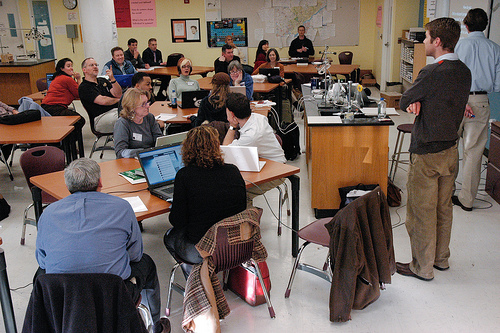A Conversation
In 2007, a then virtual-only colleague asked whether it was, “okay to be a technologically illiterate teacher?” NETS-T provides one standardized, big-picture perspective. Many others speak of new literacies unleashed by the reach of the Internet. A few have mentioned “big shifts” that define the changes and challenges to educators in rather recent history. At the other end of the spectrum, the Edu-Twittersphere offers up a litany of “gotta be using” tools on a nightly basis. Here’s the problem from where I see it: we have a gap.

On Sunday, the 29th, I’m leading a session at Educon 2.4 to drag a room of interested educators into that gap to poke around for 90 minutes or so. It’s like this: to the typical classroom teacher, things like “new literacies” and cultural shifts are pretty stratospheric. That’s not a value judgement in any way- it’s just the way I see it in my experiences working with teachers. In defense of teachers, it is quite possible that this career has never been more challenging than it is today. But if you’re reading this blog, you likely aware of this fact already.
In 2012, there is much chatter in social spaces that are loosely-tied by educators. Collections of teachers joined by technological tendrils tend to spout the virtues of every new digital tool to hit cyberspace. So many of these startups seem to vault into the limelight in no time flat, each in turn destined to set the educational world right again. Hype travels fast in a world devoid of complexity and nuance. Take Twitter for example. Twitter has been co-opted by educators in what is perhaps one of the most productive uses of its potential to date. That said, the media always affects the message, and 140 characters leaves much nuance at the door. Sure, you can hyperlink to meatier reflections, but that isn’t the norm.

So what do we discuss on the Twitter? More often than not: tools. We all get value out of the “head’s up” links on Twitter to new and interesting digital applications that -on the surface- promise innovation. And yet, I’d argue that tip-offs to shiny apps do little on their own to advance our understanding of the effects of this communications revolution. Who knows, perhaps we’re not meant to grasp the breadth and depth of a revolution in its very midst? Personally, I think education has to make an attempt to fly the ship while installing more effective wings. To ignore the challenge is to allow children fly a plane alone- and with untested wings. Life moves too fast and recent changes seem too profound I do know this: digital tools won’t educate a child any more than a hammer will build a house. Think of it this way: what does a carpenter need to know, and be able to do in 2012? And if you’re an administrator, perhaps you’d better think like a contractor. Yes, the metaphor is a mess, but it’s worth the ride. Take it…
Think of it this way: what does a carpenter need to know, and be able to do in 2012?
The Gap
So that’s it? Pin the standards to your chest and guess… or chase each and every new app to debut? Is that the life of an enlightened educator in 2012? I doubt it. And yet, I’m also pretty certain that the classic ostrich pose in these times won’t cut it either. I’m betting a solid path to improvement is to be found within the gap. I was once a somewhat “reluctant technologist.” I never wanted to be seen as an evangelist of shiny gadgets. Now, I’m proud to say that I live my professional life within that gap. I spend my days helping teachers connect tools and processes to concepts, and sometimes rather lofty instructional goals and ideals. I work with principals and building administrators in seeing the big picture of how instruction can look. It is my role to assure that solid instruction leads the way in any implementation of technology… as opposed to gadgets.
So what exactly is this “gap,” if indeed it does exist? Well, that’s just it. That gap is why I decided to attempt to frame this question. It is also why I intend to leave my opinions out of this preview, as well as the framing of the question to begin my session.

One thing I do know: the room that day will be full of smart, passionate educators with varied knowledge and experiences. I already know what I have experienced. I want to learn more. I want input, and I don’t want that input clouded in any way by my own ideas at the outset. I want to walk away from Philly with either a disrupted or a clarified vision. Either way, it will help me refine, in at least some small way, what I do on a daily basis. It will shape how I think, what I plan, how I talk, and what I do in the months to come. A conference where the presenters themselves come to learn? That is pretty big from where I sit. Come to Educon. Join us. Come to my session, and let’s chat. Thanks again, Chris and team, for doing it this way…
Artwork
*”Educon 2.4 Icon” from the Educon 2.4 website *”email symbol” by Micky Aldridge via CC from Flickr *”Educon21_satsun_110” by Sarah Sutter via CC from Flickr